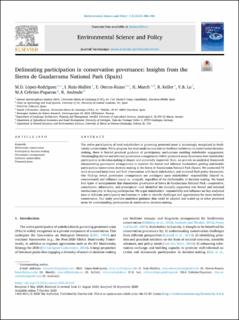| dc.contributor.author | Lopez-Rodríguez, M.D. | |
| dc.contributor.author | Ruiz-Mall´en, I. | |
| dc.contributor.author | Oteros-Rozas, E. | |
| dc.contributor.author | March, H. | |
| dc.contributor.author | Keller, Rose | |
| dc.contributor.author | Lo, V.B. | |
| dc.contributor.author | Cebrian-Piqueras, M.A | |
| dc.contributor.author | Andrade, R. | |
| dc.coverage.spatial | Spania | en_US |
| dc.date.accessioned | 2020-10-14T10:47:57Z | |
| dc.date.available | 2020-10-14T10:47:57Z | |
| dc.date.created | 2020-10-09T09:39:35Z | |
| dc.date.issued | 2020 | |
| dc.identifier.citation | Environmental Science and Policy. 2020, 114 486-496. | en_US |
| dc.identifier.issn | 1873-6416 | |
| dc.identifier.uri | https://hdl.handle.net/11250/2682739 | |
| dc.description.abstract | The active participation of local stakeholders in governing protected areas is increasingly recognized in biodiversity conservation. While progress has been made in countries to facilitate inclusivity in conservation decisionmaking, there is limited practical guidance of participatory mechanisms enabling stakeholder engagement. Disentangling formal and informal governance arrangements within protected areas illuminates how stakeholder participation in decision-making is shaped and potentially improved. Here, we provide an analytical framework characterising governance arrangements to examine the formal and informal mechanisms guiding stakeholder participation conservation decision-making in the Sierra de Guadarrama National Park (Spain). We conducted 76 semi-structured interviews and field observations with local stakeholders, and reviewed Park policy documents. Our findings reveal governance arrangements are contingent upon stakeholders’ responsibility (shared vs. concentrated) and influence (equal vs. unequal), regardless of the (in)formality of decision making. We found four types of arrangements that characterise governance of Sierra de Guadarrama National Park—cooperative, consultative, informative, and prescriptive—and identified the mutually supportive role formal and informal mechanisms play in shaping participation. We argue stakeholders’ responsibility and influence are key analytical axes to delineate participatory mechanisms in order to identify challenges and opportunities for more inclusive conservation. Our study provides analytical guidance that could be adapted and scaled up to other protected areas for understanding participation in conservation decision-making. | en_US |
| dc.language.iso | eng | en_US |
| dc.rights | Navngivelse 4.0 Internasjonal | * |
| dc.rights.uri | http://creativecommons.org/licenses/by/4.0/deed.no | * |
| dc.title | Delineating participation in conservation governance: Insights from the Sierra de Guadarrama National Park (Spain) | en_US |
| dc.type | Peer reviewed | en_US |
| dc.type | Journal article | en_US |
| dc.description.version | publishedVersion | en_US |
| dc.rights.holder | © 2020 The Author(s). | en_US |
| dc.source.pagenumber | 486-496 | en_US |
| dc.source.volume | 114 | en_US |
| dc.source.journal | Environmental Science and Policy | en_US |
| dc.identifier.doi | 10.1016/j.envsci.2020.09.019 | |
| dc.identifier.cristin | 1838387 | |
| cristin.ispublished | true | |
| cristin.fulltext | original | |
| cristin.qualitycode | 1 | |

